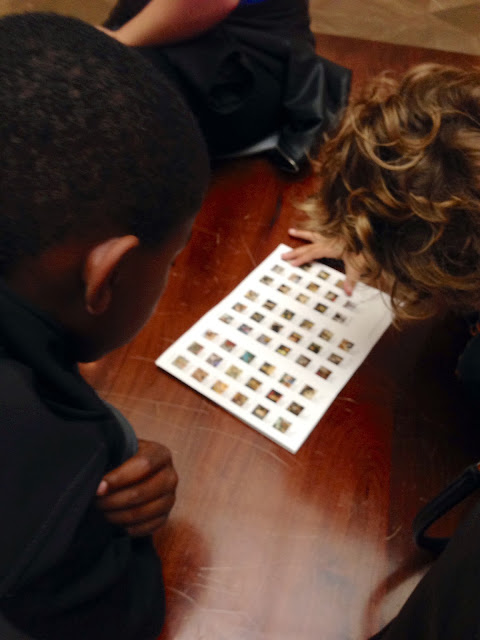SCAVENGER HUNT
Our final day in Madrid and I was finally able to drag the kids to the Prado Museum.
The Museo del Prado is the main Spanish national art museum, located in centralMadrid. It features one of the world's finest collections of European art, from the 12th century to the early 19th century, based on the former Spanish Royal Collection, and unquestionably the best single collection of Spanish art. Founded as a museum ofpaintings and sculpture, it also contains important collections of other types of works. A new, recently opened wing enlarged the display area by about 400 paintings, and it is currently used mainly for temporary expositions. El Prado is one of the most visited sites in the world, and it is considered to be among the greatest museums of art. The large numbers of works by Francisco de Goya, the artist most extensively represented in the collection, and by Diego Velázquez, Titian, Peter Paul Rubens and Hieronymus Boschare among the highlights of the collection.
Monument to Francisco Goya marks the northern entrance to the Prado Museum.
Francisco José de Goya y Lucientes ( 30 March 1746 – 16 April 1828) was a Spanish romantic painter and printmaker regarded both as the last of the Old Masters and the first of the moderns.
The plan I concocted was a scavenger hunt!
I researched about eight famous paintings and wrote a question regarding it's meaning, what it depicts or the history of the painting. In order to make it manageable for the kids I was able to discover each painting's location by room number before they started. The boys had my 8 questions (with hints), a museum map, and the room number of the painting with corresponding question number. Their job was to discover the artist and the name of the paiting. Yes, this took me some time in morning before heading to the museum. The prize would be 5 euros!
The boys agreed and may even have been excited for the challenge.
The first successful find, the answer the question #3.
The Third of May 1808 is a painting completed in 1814 by the Spanish painterFrancisco Goya, now in the Museo del Prado, Madrid. In the work, Goya sought to commemorate Spanish resistance to Napoleon's armies during the occupation of 1808 in the Peninsular War.
The painting's content, presentation, and emotional force secure its status as a groundbreaking, archetypal image of the horrors of war. Although it draws on many sources from both high and popular art, The Third of May 1808 marks a clear break from convention. Diverging from the traditions of Christian art and traditional depictions of war, it has no distinct precedent, and is acknowledged as one of the first paintings of the modern era. According to the art historianKenneth Clark, The Third of May 1808 is "the first great picture which can be called revolutionary in every sense of the word, in style, in subject, and in intention".
Yes, many of the paintings throughout this museum are graphic and or depressing. There was no real way to avoid it so we went with it and tried not to dwell too long. (warning don't scroll further down with young eyes watching -- check first)
The boys moved along well and found all the paintings on the scavenger hunt and even enjoyed looking for a few more of the masterpieces that caught their eye.
Roman choose to investigate the below painting by Goya after reading its name.
Mabret's favorite - distinctly different from Roman's - as it involves nice dreams!
Jacob's Dream
This painting by Jose de Ribera tells of Jacob the Patriarch’s mysterious dream, as told in Genesis. He appears asleep, lying on his left shoulder with a tree behind him. On the other side is the ladder of light, by which the angels ascend and descend.
This subject demonstrates Ribera’s skill at constructing metaphoric discourse. He uses the image of a shepherd resting in the countryside to describe one of the best-known Bible stories. The foreground view of the solidly constructed figure and the scene’s realistic features bring realism to the miraculous dream described in a ray of light under a blue and gray sky.
Here, Ribera offers one of the numerous proofs of his delicate sense of color and his exquisite compositional capacity, masterfully placing the foreground volumes in diagonal contraposition.
The Drowning Dog
Another of Goya's Black paintings These were painted after an illness at age 46 caused him to become deaf and suffer with mental issues. They were painted on the walls of his home in Madrid and were not meant for others to see.
Finally, Las Meninas (Spanish for The Maids of Honour) is a 1656 painting by Diego Velázquez, the leading artist of the Spanish Golden Age, in the Museo del Prado in Madrid. The work's complex and enigmatic composition raises questions about reality and illusion, and creates an uncertain relationship between the viewer and the figures depicted. Because of these complexities, Las Meninas has been one of the most widely analyzed works in Western painting.
Las Meninas has long been recognised as one of the most important paintings in Western art history. More recently, it has been described as "Velázquez's supreme achievement, a highly self-conscious, calculated demonstration of what painting could achieve, and perhaps the most searching comment ever made on the possibilities of the easel painting".
Even a short amount of time just being surrounded by the masters is better then no time at all.
Peace out from del Prado, Madrid.













